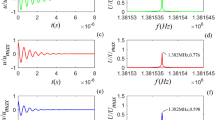Abstract
The velocity of sound has been measured in ice with temperatures from the melting point to −140°C, using two different supersonic pulse methods. The complete set of the five elastic moduli has been determined from the measurements for the above mentioned temperature range. To explain various results for piezoelectricity, density and elastic moduli a model of an aging process is discussed.
Zusammenfassung
Mit zwei voneinander unabhängigen Ultraschall-Impulsmethoden wurden die Schallgeschwindigkeiten in Eis vom Schmelzpunkt bis −140°C gemessen. Aus diesen Werten wurde für den genannten Temperaturbereich der vollständige Satz der fünf elastischen Moduln berechnet. Ferner wird das Modell eines Alterungsprozesses vorgeschlagen, durch den unterschiedliche Ergebnisse beim Piezoeffekt, der Dichte und den elastischen Moduln geklärt werden können.
Résumé
La vitesse du son a été mesurée dans la glace par deux méthodes différentes dans un intervalle de température allant du point de fusion jusqu’à −140°C. Le jeu complet des cinq modules d’élasticité a été déterminé à partir de ces mesures dans le domaine de température cité. Un modèle des processus de vieillissement est proposé, qui permet d’expliquer les observations de la piézoélectricité, de la densité et des modules d’élasticité.
Similar content being viewed by others
Literatur
Jona, F., undP. Scherrer: Helv. phys. Acta25, 35 (1952).
Bass, R., D. Rossberg undG. Ziegler: Z. Phys.149, 199 (1957).
Brockamp, B., undH. Querfurth: Z. Polarforsch.5, 253 (1964).
Bogorodskii, V. V.: Soviet Physics-Acoustics10, 124 (1964).
Zarembowitch, A.: Bull. Soc. Franc. Minéral. Crist.LXXXVIII, 17 (1965).
Proctor, M., jr.: JASA39, 972 (1966).
Dantl, G.: Diss. TH Stuttgart 1967.
Cady, W. G.: Piezoelectricity. New York: Dover Publ., Inc. 1964.
Penny, A. H. A.: Proc. Cambridge Phil. Soc.44, 423 (1948).
Deubner, A., R. Heise undK. Wenzel: Naturwissenschaften47, 600 (1960).
Teichmann, I., undG. Schmidt: Phys. Stat. solidi8, K 145 (1965).
Rossmann, F.: Experimentia6, 182 (1950).
Dorsey, N. E.: Properties of Ordinary Water-Substance. New York: Reinhold Publ. Corp. 1957.
Dantl, G., undI. Gregora: Naturwissenschaften55, 176 (1968).
Lippincott, E. R., undR. Schroeder: J. chem. Phys.23, 1099 (1955).
Hadži, D. (ed.): Hydrogen Bonding. London: Pergamon Press 1959.
Dantl, G.: Z. Phys.166, 115 (1962); Z. Phys.169, 466 (1962).
Workman, E. J., andS. E. Reynolds: Phys. Rev.78, 254 (1950).
McSkimin, H. J.: In:Mason (ed.): Physical Acoustics IA. New York: Academic Press 1964.
Author information
Authors and Affiliations
Rights and permissions
About this article
Cite this article
Dantl, G. Die elastischen Moduln von Eis-Einkristallen. Phys kondens Materie 7, 390–397 (1968). https://doi.org/10.1007/BF02422784
Received:
Issue Date:
DOI: https://doi.org/10.1007/BF02422784




